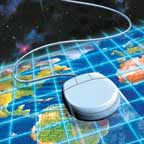The ABCs of GIS

You’ve probably heard the acronym “GIS” and wondered what it means. In the simplest terms, a Geographic Information System (GIS) is a smart map that instantly can give you information from map features. For example, a digital map of land parcels can tell you various things about each parcel such as ownership, acreage, address, and taxable value. The GIS will provide data and graphics based on its link between the object location and the object information.
There are a variety of potential uses for GIS technology. Some of the more common uses include land records management, zoning administration, emergency management, tax assessing, utility system management, marketing, site selection analysis, corridor management, and facilities management.
While GIS has been used predominantly by government agencies to date, businesses are starting to realize the benefits GIS can provide. Many large retailers now use GIS to assist in performing demographic analyses to help locate new markets. The retailer can input criteria such as demographic profiles, proximity to transportation corridors, zoning, minimum lot size requirements, and availability of utilities to quickly get an answer in a graphic form. For example, if a company marketed a product to men in a certain income range, GIS could identify areas where these men resided in large concentrations. If the company then wanted to build a store near those concentrations, it could further query for a list of available parcels that meet zoning and size requirements.
GIS is also an important emergency management tool. Many E-911 Central Dispatch Authorities are implementing GIS to assist them in locating incidents and to more efficiently dispatch emergency vehicles, thus saving time and lives. The dispatcher has a live map display showing the location of all emergency vehicles via a specialized Global Positioning System (GPS) known as Automated Vehicle Location system (AVL). When an emergency call comes in, the address is mapped on the same display. The dispatcher then has the ability to graphically see both the location of the emergency vehicles and the incident. This allows the dispatcher to send the closest vehicle. This same technology now is being implemented by businesses to track their vehicles and more efficiently route them to destinations.
Owner notification is another growing use of GIS, primarily among utilities. A zoning administrator can use GIS to quickly find all property owners and their addresses that are within 300 feet of a proposed re-zoning. A properly configured GIS performs this function in a matter of seconds, versus the time-consuming method of paper maps and cards.
There are many factors in establishing a successful GIS, the first being proper planning. A good GIS consultant can facilitate the rapid implementation of both large and small projects. You also should look for a GIS consultant with a solid background and knowledge of GIS, sufficient computer hardware and networks, and ample resources to provide the necessary knowledge and training for the system. Finally, all reputable companies should provide resumes of their employees and a client reference list. IBI

